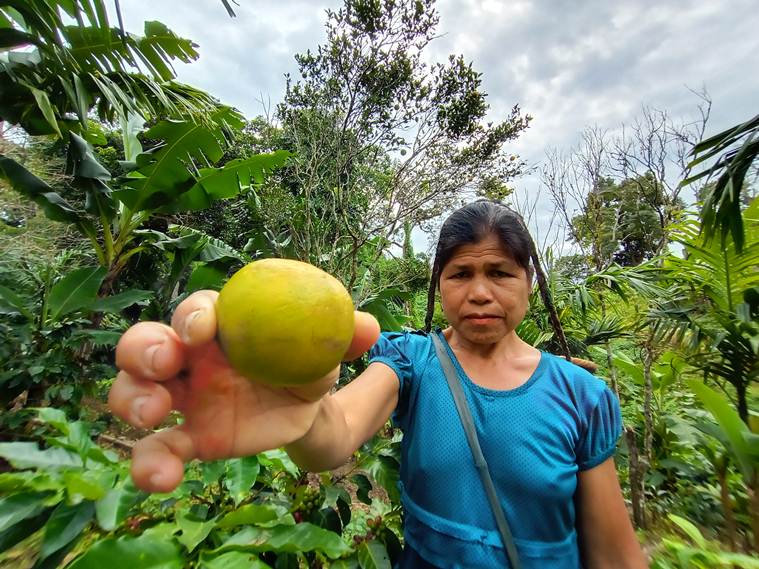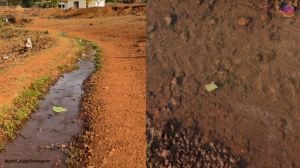- India
- International
Is Tripura’s ‘Jampui Kamola’ a thing of the past?
Eight decades after its first production, Jampui Kamola has seen a downfall. While farmers blame crop failure for repeated losses, the state government has largely chosen to hold them responsible for the condition.
 Jawhar Saha, an orange vendor at Agartala city, pulls on his cart of oranges.
Jawhar Saha, an orange vendor at Agartala city, pulls on his cart of oranges.
Jampui Hills, located 210 km away from Agartala at an elevation of 3200 ft above sea level, right across the Tripura-Mizoram boundary, is famous for its sweet, luscious oranges. The tantalizing sweetness of the small-sized oranges fittingly earned a name of Jampui Kamola (orange) over the decades.
Back in the 1960s, tribal villagers in Jampui Hills — mostly inhabited by Reang and Lushai (Mizo) communities, produced oranges purely for domestic consumption. With increasing export, ‘Kamola’ became a significant cash crop in the area and nearly 1,000 hectares of hilly terrain was covered with orange plantations by the eighties.
However, eight decades after its first production, the crop has seen a downfall. Jampui Kamola is now grown in no more than 100 hectares. While farmers blame crop failure for repeated losses, the state government has largely chosen to hold them responsible for the condition.
So what’s the problem?
Since the last 19 years, oranges in Jampui aren’t making profits for their growers. Sothungrai Reang, a 76-year-old man from Phuldungsei village, says he has been growing oranges for the last 43 years but the fruit is no more profitable. “Since 2000, the trees started developing ‘bemari’ (disease). We have tried many things. Government officers gave us solutions but nothing worked out quite right”, he told indianexpress.com. Sothungrai has 11.5-hectare ancestral land, where he now grows coffee, areca nut, banana. He also grows oranges in a small portion of his land.

Another farmer, Lapui Lushai says a similar story. “Orange crops were not good. So, we shifted to areca nut and coffee.”. Many farmers also say that the fruit doesn’t fetch good prices in the market as huge profits are pocketed by middlemen.
 Josuki Reang of Vangmun village in Jampui Hills shows off orange grown in her plantation.
Josuki Reang of Vangmun village in Jampui Hills shows off orange grown in her plantation.
Is Jampui Kamola a thing of past?
In order to develop Baramura ADC village as the next big orange destination of Tripura, the state government has provided Rs. 15,000 assistance per hectare to 200 orange growing families. It has also shifted ‘Kamola Utsav’ — a festival started in mid-eighties after Jampui Kamola was awarded the first prize at Delhi Fruits Exhibition — to Baramura Hills this year, where incumbent BJP-IPFT government is trying to reshape orange plantations, triggering questions if ‘Jampui Kamola’ is a thing of the past now.
What does the government say?
In a press conference, Tripura Agriculture Minister Pranajit Singha Roy Wednesday said, “Oranges were earlier grown in Jampui Hills. Now those are almost finished. We have provided assistance and support to 200 orange growers at Baramura Hills, where there is a good potential of orange cultivation. They have produced nearly double volume of oranges from last year at Baramura”.
Asked about his take on Jampui oranges, the minister said many factors including rapid deforestation, climate change, population boom and shift in cropping choices have caused Jampui orange crops to go down over last few decades.
State Agriculture Director DP Sarkar said orange plants at Jampui suffered from three main types of diseases. These include two fungal diseases – powdery mildew and dieback, and anthracnose, a bacterial infection of the citrus plants.
 Orange trees bearing fruit at Tlakshi village in Tripura’s Jampui Hills.
Orange trees bearing fruit at Tlakshi village in Tripura’s Jampui Hills.
“Dealing with these diseases needs proper spraying from the topmost villages in the hill. We have tried to explain growers the importance of this, demonstrated the method, even provided support. But many of them don’t want to go the extra mile since water needed for spraying is scarce in the hills and it is a tiring task,” he said.
What’s ahead?
Agriculture minister Pranajit Singha Roy said his department will start an experiment on 5-hectare land at Jampui Hills to check out if ‘Jampui Kamola’ can indeed be revived. “If we can invest in Baramura, we shall surely not forget Jampui. We shall conduct an experiment on 5-hectare land chosen at Jampui Hills. Everything needed to revive Jampui oranges will be done”, he assured.
Apr 26: Latest News
- 01
- 02
- 03
- 04
- 05








































